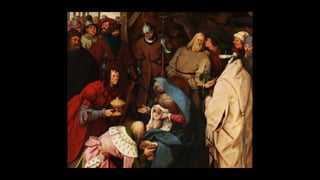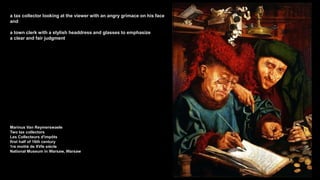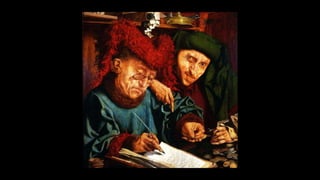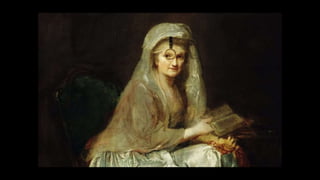Glasses in paintings
- 3. The first glasses in history, called besicles, appeared around 1280 in Northern Italy. In 1352 Tomaso da Modena, painted the portrait of cardinal Hugues de Provence with besicles when in reality he could never have worn them as they had not yet been invented at the time of his life. Hug lived and died long before his invention ... But the picture it shows how early was the association between wisdom and glasses.
- 5. The earliest depiction of spectacles in a painted work of art. Depicts Cardinal Hugh of Provence, Hugh de St. Cher, at his writing desk wearing a pair of rivet spectacles Tomaso da Modena painted the portrait of cardinal with besicles, but Hugh de St. Cher actually died in the 1260s and could never have worn spectacles! Tommaso da Modena Portrait of Hugh of Saint-Cher Portrait d'Hugues de Saint-Cher 1351-1352 Chapter House, San Niccolò, Treviso
- 8. Christ’s apostles visit the Virgin upon her deathbed. Saint Peter, wearing white robes and the papal tiara, performs funerary rites, reciting prayers and sprinkling holy water on the Virgin’s body. Two apostles sit on a wide bench in front of the bed, reading. The one on the left presses the rivet of his spectacles to his forehead and brings the book close to his eyes in an attempt to see the text - very likely the prayers for the dead - a bit better. Master of Heiligenkreuz The Death of the Virgin La Mort de la Vierge 1400 Museum of Art, Cleveland
- 13. Pentecost ... the Virgin on the throne, the two princes of the Church Peter and Paul, three books and the apostle of glasses "Glasses Apostle" is considered the oldest depiction of eyeglasses north of the Alps. Conrad von Soest Wildunger Altar, Pentecost, panel from the Wildunger Altarpiece, The Apostle of Glasses Retable de Bad Wildungen, la Pentecôte, Apôtre aux bésicles 1403 Saint Nikolaus Parish church, Bad Wildungen
- 16. Herlin immortalized the circumcision of Christ by a high priest with riveted glasses! The glasses appear here as a "medical auxiliary instrument". Without his glasses, the high priest would hardly be able to carry out the "operation". Friedrich Herlin Twelve Apostles Altar, detail Circumcision of Christ Retable des Douze Apôtres, détail Circoncision de Jésus 1466 St. Jakob Church, Rothenburg ob der Tauber
- 20. The invention of the glasses must have made a strong impression on Herlin. This work represents Saint Peter wearing clouants. Unable to stay on the face alone, this model had to be held by hand. Friedrich Herlin Twelve Apostles Altar, detail Reading Saint Peter Retable des Douze Apôtres, détail Saint Pierre 1466 St. Jakob Church, Rothenburg ob der Tauber
- 24. the Virgin Mary enthroned with the Christ Child on her lap, St. Donatian, Saint George and donor Joris van der Paele Van der Paele The canon is represented with clouants, the first type of glasses ever invented: two convex glass lenses held by circles and linked by a nail. Jan van Eyck Virgin and Child with Canon van der Paele La Vierge au chanoine Van der Paele 1436 Groeningemuseum, Bruges
- 28. the baby Jesus resting on the lap of his mother the Virgin Mary, the elderly Joseph, listening to one of three men, the kings a donkey, the soldiers menacing and the spectators bewildered: one is wearing a pair of spectacles, with his corrected visual impairment it seems to devour with the eyes the riches brought by the kings, just like these companions. Pieter Bruegel the Elder, Pieter Brueghel l'Ancien The Adoration of the Kings L'Adoration des mages 1564 National Gallery, London
- 33. Saint Thomas, the doubting apostle, the last to arrive, running to ask Our Lady to leave behind her belt ... and puts on his glasses to see if the Virgin Mary has really ascended into heaven Lorenzo Lotto Assumption of the Virgin L'Assomption de la Vierge 1512 Pinacoteca di Brera, Milani
- 36. a market, a young man prepares the unguents, an aged holds the head and a barber surgeon carrying out a trepanation (and another patient grimaces grotesquely while waiting his turn ...) Jan Sanders van Hemessen The Surgeon, or The Extraction of the Stone of Madness L'Excision de la pierre de folie 1550-1555 Museo del Prado, Madrid
- 40. a tax collector looking at the viewer with an angry grimace on his face and a town clerk with a stylish headdress and glasses to emphasize a clear and fair judgment Marinus Van Reymerswaele Two tax collectors Les Collecteurs d'impôts first half of 16th century 1re moitié de XVIe siècle National Museum in Warsaw, Warsaw
- 44. In many depictions of Saint Jerome his glasses sit on or near his writing desk, as the instrument of the scholar. However, the appearance of glasses in the images of the saint are anachronistic: lived and died well before their invention. In Jerome's case, the anachronism was so persistent that he became the patron saint of spectacle makers. Joos van Cleve Saint Jerome in His Study Saint Jérôme 1521 Harvard Art Museums, Harvard University, Cambridge
- 49. the Virgin sitting in her bed, her eyes half closed, surrounded by the apostles who occupy the entire space of the room a priest, sketching a sign of the cross seems to give the Virgin the last sacraments a kneeling figure with spectacles, book in hand, mouth half open, reciting prayers Maître de Santa Clara de Palencia, Master of Santa Clara de Palencia La mort de la Vierge Death of the Virgin 1500-1507 Musée des beaux-arts de Lyon, Lyon
- 53. The cardinal in this work is wearing a model of glasses that was very popular in 16th Century Spain. They are held in place with a ribbon that is hooked over the ears, allowing them to be held in place better than the armless besicles that were around at the time. El Greco Cardinal Fernando Niño de Guevara 1600 Metropolitan Museum of Art, Manhattan, New York
- 57. a leering, sneering young man, a disreputable lady lwinks knowingly at us and an older woman with glasses; the 17th century viewer would have easily recognized it: a procuress, a celestina from Spanish picaresque literature, depicted with spectacles and a headscarf Bartolome Esteban Murillo Four Figures on a Step Quatre personnages sur une marche d’escalier 1655-1660 Kimbell Art Museum, Fort Worth
- 61. a fortune teller, wearing tight pince-nez glasses, reads the palm of a “miles gloriosus”, who is clearly worried and frightened by what he hears … Pietro della Vecchia A Fortune-Teller Reading the Palm of a Soldier Un diseur de bonne aventure lisant la paume d'un soldat 1660 Wellcome Collection
- 65. Yet more formidable ... a learned matriarch sporting a fantastic monocle - drawing attention to her eye, and thus the artist's gaze Anna Dorothea Therbusch Self-Portrait with Monocle Autoportrait au monocle 1777 Gemäldegalerie, Staatliche Museen, Berlin
- 68. The painter, suffering with an eye affliction, was forced to wear glasses towards the end of his life. In this work, we can see a pair of armless besicles, a popular design at the time. This model clung to the nose, preventing them from needing to be held by hand, while at the same time preventing the wearer from breathing through the nose. Jean Baptiste Siméon Chardin Self-portrait in glasses Autoportrait aux bésicles 1771 Musée du Louvre, Paris
- 71. A few years later, the painter is back, this time with new glasses that hold on to the face with arms rather than clinging to the nose. This design was no less inconvenient: they squeezed the temples and caused headaches, explaining why in a later self-portrait, we can see that the artist has returned to the first pair. Jean Baptiste Siméon Chardin Autoportrait à l’abat-jour et aux lunettes Self-Portrait with a Visor 1775 Art Institute of Chicago, Chicago
- 74. a tribute to a friend, the poet Apollinaire … a “premonitory” target on the temple of the shadow-figure representing the poet indicates the spot where he would be struck by a shell-fragment in 1916; a fish and a shell, the attributes of Orpheus, symbolically refer to poetry, an art endowed with divinatory power; a stone bust with black glasses alludes to the blind ancient prophet Tirésias, the sunglasses symbolize blindness, which in Greek mythology was associated with wisdom. ... a man of stone, wearing blind man's glasses. He looks right at us, however: his blindness is that of the seer, the poet. Giorgio De Chirico Portrait (prémonitoire) de Guillaume Apollinaire Portrait (premonitary) of Guillaume Apollinaire 1914 Centre Pompidou, Paris
- 79. olga_oes Glasses in paintings Les lunettes dans la peinture images and text credit www. Music The Piano Guys Limitless created olga.e. thanks for watching















































































